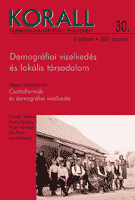Adatok a pestisjárványok magyarországi történetéhez. A máramarosi példa
Sources for the History of Plague Epidemics in Hungary: The case of Máramaros County
Author(s): Tamás FaragóSubject(s): History
Published by: KORALL Társadalomtörténeti Egyesület
Summary/Abstract: This paper discusses the demographic eff ects of the plague epidemics in the historical county of Máramaros (in present-day Ukraine and Romania). Its aim is to formulate a methodology which is suitable for the historical analysis of disasters in a region whose past is not recorded in parish registers. (Prior to the last plague epidemic in 1738, more than half of the Kingdom of Hungary was without parish registers. – Table 1, Figure 1). Certain regions and religious denominations cannot be researched with this methodology at all. Based on the tax registers of both 1710 and 1742 (Table 3 and Table 7 respectively) the eff ects of the plague can be detected. The sources, however, lend themselves to a demographically relevant analysis only in the case of the last epidemic in the year 1742. Based on these sources it is possible to determine the duration of the epidemic in each settlement (Table 5) and its diverse impact on spatial and cultural groups of the population (Map 1, Tables 4 and 6). The examination of some settlements in detail affi rms the observations of the research so far: the plague aff ected all age groups, but the proportion of women and heads of families is lower than average. The epidemic did not aff ect all status groups equally (Table 8, Fig. 2). The number of people infl icted with the plague altogether is nearly 60% of the total population of the county and 40-42% of the total population died in 1742 (Tables 9 and 10). Nevertheless, factors like the age at marriage being lower than population in a relatively short time. Moreover, despite the two highly destructive plague epidemics, the population of Máramaros at the time of the first census in 1785 was two and a half times bigger than it was in the beginning of the eighteenth century (Table 12). Both the chronology of the plague epidemics of the Carpathian Basin, and the ensuing reconstruction of population show diff erent patterns than those of the Western European plague epidemics of the seventeenth century.
Journal: Korall - Társadalomtörténeti folyóirat
- Issue Year: 2007
- Issue No: 30
- Page Range: 19-30
- Page Count: 42
- Language: Hungarian

